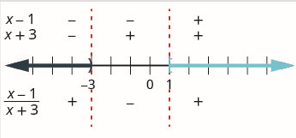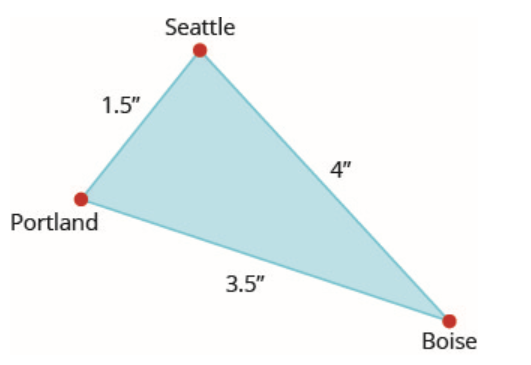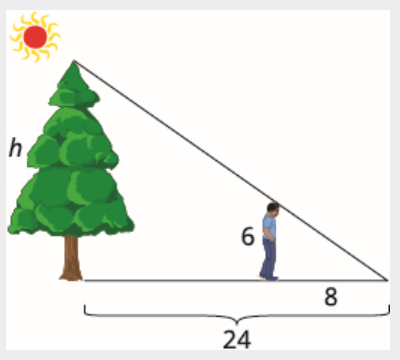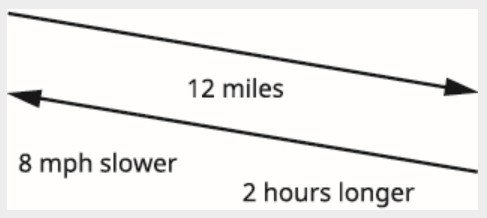7.6: Solve Applications with Rational Equations
( \newcommand{\kernel}{\mathrm{null}\,}\)
- Solve proportions
- Solve similar figure applications
- Solve uniform motion applications
- Solve work applications
- Solve direct variation problems
- Solve inverse variation problems
Before you get started, take this readiness quiz.
- Example 2.2.13. Example 2.5.13. Example 2.2.9.
Solve Proportions
When two rational expressions are equal, the equation relating them is called a proportion.
A proportion is an equation of the form ab=cd, where b≠0,d≠0.
The proportion is read “a is to b as c is to d.”
The equation 12=48 is a proportion because the two fractions are equal. The proportion 12=48 is read “1 is to 2 as 4 is to 8.”
Since a proportion is an equation with rational expressions, we will solve proportions the same way we solved rational equations. We’ll multiply both sides of the equation by the LCD to clear the fractions and then solve the resulting equation.
Solve: nn+14=57.
Solution
nn+14=57,n≠−14
Multiply both sides by LCD.
7(n+14)(nn+14)=7(n+14)(57)
Remove common factors on each side.
7n=5(n+14)
Simplify.
7n=5n+70
Solve for n.
2n=70n=35
Check.
nn+14=57
Substitute n=35
3535+14?=57
Simplify.
3549?=57
Show common factors.
5⋅77⋅7?=57
Simplify.
57=57√
Solve the proportion: yy+55=38.
- Answer
-
y=33
Solve the proportion: zz−84=−15.
- Answer
-
z=14
Notice in the last example that when we cleared the fractions by multiplying by the LCD, the result is the same as if we had cross-multiplied.
nn+14=57nn+14=577(n+14)(nn+14)=7(n+14)(57)nn+14=577n=5(n+14)7n=5(n+14)
For any proportion, ab=cd, we get the same result when we clear the fractions by multiplying by the LCD as when we cross-multiply.
ab=cdab=cdbd(ab=cd)bdab=cdad=bcad=bc
To solve applications with proportions, we will follow our usual strategy for solving applications But when we set up the proportion, we must make sure to have the units correct—the units in the numerators must match each other and the units in the denominators must also match each other.
When pediatricians prescribe acetaminophen to children, they prescribe 5 milliliters (ml) of acetaminophen for every 25 pounds of the child’s weight. If Zoe weighs 80 pounds, how many milliliters of acetaminophen will her doctor prescribe?
Solution
Identify what we are asked to find, and choose a variable to represent it.
How many ml of acetaminophen will the doctor prescribe?
Let a=ml of acetaminophen.
Write a sentence that gives the information to find it.
If 5 ml is prescribed for every 25 pounds, how much will be prescribed for 80 pounds?
Translate into a proportion—be careful of the units.
Step 1. Write the inequality as one quotient on the left and zero on the right. Our inequality is in this form.
x−1x+3≥0
Step 2. Determine the critical points-the points where the rational expression will be zero or undefined.
The rational expression will be zero when the numerator is zero. Since x−1=0 when x=1, then 1 is a critical point. The rational expression will be undefined when the denominator is zero. Since x+3=0 when x=−3, then -3 is a critical point.
Step 3. Use the critical points to divide the number line into intervals.

Step 4. Above the number line show the sign of each factor of the rational expression in each interval. Below the number line show the sign of the quotient.
Use values in each interval to determine the value of each factor in the interval. In the interval (-3,1), zero is a good value to test. For example, when x=0 then x−1=−1 and x+3=3 The factor x−1 is marked negative and x+3 marked positive. Since a negative divided by a positive is negative, the quotient is marked negative in that interval.
Step 5. Determine the intervals where the inequality is correct. Write the solution in interval notation.

We want the quotient to be greater than or equal to zero, so the numbers in the intervals (−∞,−3) and (1,∞) are solutions. Since 3 must be excluded since it makes the rational expression 0, we cannot include it in the solution. We can include 1 in our solution.
(−∞,−3)∪[1,∞)
Multiply both sides by the LCD, 400. Remove common factors on each side. Simplify, but don’t multiply on the left. Notice what the next step will be.
16⋅5=5a
Solve for a.
16⋅55=5a516=a
Check. Is the answer reasonable? Write a complete sentence.
The pediatrician would prescribe 16 ml of acetaminophen to Zoe.
Pediatricians prescribe 5 milliliters (ml) of acetaminophen for every 25 pounds of a child’s weight. How many milliliters of acetaminophen will the doctor prescribe for Emilia, who weighs 60 pounds?
- Answer
-
The pediatrician will prescribe 12 ml of acetaminophen to Emilia.
For every 1 kilogram (kg) of a child’s weight, pediatricians prescribe 15 milligrams (mg) of a fever reducer. If Isabella weighs 12 kg, how many milligrams of the fever reducer will the pediatrician prescribe?
- Answer
-
The pediatrician will prescribe 180 mg of fever reducer to Isabella.
Solve similar figure applications
When you shrink or enlarge a photo on a phone or tablet, figure out a distance on a map, or use a pattern to build a bookcase or sew a dress, you are working with similar figures. If two figures have exactly the same shape, but different sizes, they are said to be similar. One is a scale model of the other. All their corresponding angles have the same measures and their corresponding sides have the same ratio.
Two figures are similar if the measures of their corresponding angles are equal and their corresponding sides have the same ratio.
For example, the two triangles in Figure below are similar. Each side of ΔABC is four times the length of the corresponding side of ΔXYZ.

This is summed up in the Property of Similar Triangles.
If ΔABC is similar to ΔXYZ, then their corresponding angle measure are equal and their corresponding sides have the same ratio.

To solve applications with similar figures we will follow the Problem-Solving Strategy for Geometry Applications we used earlier.
On a map, San Francisco, Las Vegas, and Los Angeles form a triangle. The distance between the cities is measured in inches. The figure on the left below represents the triangle formed by the cities on the map. If the actual distance from Los Angeles to Las Vegas is 270 miles, find the distance from Los Angeles to San Francisco.

Solution
Since the triangles are similar, the corresponding sides are proportional.
Read the problem. Draw the figures and label it with the given information. The figures are shown above.
Identify what we are looking for: the actual distance from Los Angeles to San Francisco
Name the variables: Let x = distance from Los Angeles to San Francisco.
Translate into an equation. Since the triangles are similar, the corresponding sides are proportional. We’ll make the numerators “miles” and the denominators “inches”.
$x miles 1.3 inches =270 miles 1 inch $
Solve the equation.
1.3(x1.3)=1.3(2701)x=351
Check. On the map, the distance from Los Angeles to San Francisco is more than the distance from Los Angeles to Las Vegas. Since 351 is more than 270 the answer makes sense.
Check x=351 in the original proportion. Use a calculator.
x miles 1.3 inches =270 miles 1 inch 351 miles 1.3 inches ?=270 miles 1 inch 270 miles 1 inch =270 miles 1 inch √
Answer the question: The distance from Los Angeles to San Francisco is 351 miles.
On the map, Seattle, Portland, and Boise form a triangle. The distance between the cities is measured in inches. The figure on the left below represents the triangle formed by the cities on the map. The actual distance from Seattle to Boise is 400 miles.

Find the actual distance from Seattle to Portland.
- Answer
-
The distance is 150 miles.
Find the actual distance from Portland to Boise.
- Answer
-
The distance is 350 miles.
We can use similar figures to find heights that we cannot directly measure.
Tyler is 6 feet tall. Late one afternoon, his shadow was 8 feet long. At the same time, the shadow of a tree was 24 feet long. Find the height of the tree.
Solution
Read the problem and draw a figure. We are looking for h, the height of the tree.

We will use similar triangles to write an equation. The small triangle is similar to the large triangle.
h24=68
Solve the proportion.
24(68)=24(h24)18=h
Simplify. Check.
Tyler's height is less than his shadow's length so it makes sense that the tree's height is less than the length of its shadow. Check h=18 in the original proportion.
68=h2468?=182434=34√
A telephone pole casts a shadow that is 50 feet long. Nearby, an 8 foot tall traffic sign casts a shadow that is 10 feet long. How tall is the telephone pole?
- Answer
-
The telephone pole is 40 feet tall.
A pine tree casts a shadow of 80 feet next to a 30 foot tall building which casts a 40 feet shadow. How tall is the pine tree?
- Answer
-
The pine tree is 60 feet tall.
Solve Uniform Motion Applications
We have solved uniform motion problems using the formula D=rt in previous chapters. We used a table like the one below to organize the information and lead us to the equation.
| Rate ⋅ Time = Distance | |||
|---|---|---|---|
The formula D=rt assumes we know r and t and use them to find D. If we know D and r and need to find t, we would solve the equation for t and get the formula t=Dr.
We have also explained how flying with or against the wind affects the speed of a plane. We will revisit that idea in the next example.
An airplane can fly 200 miles into a 30 mph headwind in the same amount of time it takes to fly 300 miles with a 30 mph tailwind. What is the speed of the airplane?
Solution
This is a uniform motion situation. A diagram will help us visualize the situation.

We fill in the chart to organize the information.
We are looking for the speed of the airplane. Let r = the speed of the airplane.
When the plane flies with the wind, the wind increases its speed and so the rate is r+30.
When the plane flies against the wind, the wind decreases its speed and the rate is r−30.
Write in the rates. Write in the distances. Since D=r⋅t, we solve for t and get t=Dr. We divide the distance by the rate in each row, and place the expression in the time column.
| Rate ⋅ Time = Distance | |||
|---|---|---|---|
| Headwind | r−30 | 200r−30 | 200 |
| Tailwind | r+30 | 300r+30 | 300 |
We know the times are equal and so we write our equation.
200r−30=300r+30
We multiply both sides by the LCD.
(r+30)(r−30)(200r−30)=(r+30)(r−30)(300r+30)
Simplify and solve.
(r+30)(200)=(r−30)300200r+6000=300r−900015000=100r
Check.
Is 150mph a reasonable speed for an airplane? Yes. If the plane is traveling 150mph and the wind is 30mph,
Tailwind 150+30=180mph300180=53 hours
Headwind 150−30=120mph200120=53 hours
The times are equal, so it checks. The plane was traveling 150mph.
Link can ride his bike 20 miles into a 3 mph headwind in the same amount of time he can ride 30 miles with a 3 mph tailwind. What is Link’s biking speed?
- Answer
-
Link’s biking speed is 15 mph.
Danica can sail her boat 5 miles into a 7 mph headwind in the same amount of time she can sail 12 miles with a 7 mph tailwind. What is the speed of Danica’s boat without a wind?
- Answer
-
The speed of Danica’s boat is 17 mph.
In the next example, we will know the total time resulting from traveling different distances at different speeds.
Jazmine trained for 3 hours on Saturday. She ran 8 miles and then biked 24 miles. Her biking speed is 4 mph faster than her running speed. What is her running speed?
Solution
This is a uniform motion situation. A diagram will help us visualize the situation.

We fill in the chart to organize the information. We are looking for Jazmine’s running speed. Let r = Jazmine’s running speed.
Her biking speed is 4 miles faster than her running speed. r+4 = her biking speed
The distances are given, enter them into the chart. Since D=r⋅t, we solve for t and get t=Dr.We divide the distance by the rate in each row, and place the expression in the time column.
| Rate \cdot Time = Distance | |||
|---|---|---|---|
| Run | r | \dfrac{8}{r} | 8 |
| Bike | r+4 | \dfrac{24}{r+4} | 24 |
| 3 | |||
Write a word sentence: Her time plus the time biking is 3 hours.
Translate the sentence to get the equation.
\dfrac{8}{r}+\dfrac{24}{r+4}=3 \nonumber
Solve.
\begin{aligned} r(r+4)\left(\dfrac{8}{r}+\dfrac{24}{r+4}\right) &=3 \cdot r(r+4) \\ 8(r+4)+24 r &=3 r(r+4) \\ 8 r+32+24 r &=3 r^{2}+12 r \\ 32+32 r &=3 r^{2}+12 r \\ 0 &=3 r^{2}-20 r-32 \\ 0 &=(3 r+4)(r-8) \end{aligned} \nonumber
\begin{array}{lc} {(3 r+4)=0} & {(r-8)=0} \\ \cancel{r=\dfrac{4}{3}} \quad & {r=8} \end{array} \nonumber
Check.
A negative speed does not make sense in this problem, so r=8 is the solution.
Is 8 mph a reasonable running speed? Yes.
If Jazmine’s running rate is 4, then her biking rate, r+4, which is 8+4=12.
\text { Run } 8 \mathrm{mph} \quad \dfrac{8 \mathrm{miles}}{8 \mathrm{mph}}=1 \text { hour } \nonumber
\text { Bike } 12 \text { mph } \quad \dfrac{24 \text { miles }}{12 \mathrm{mph}}=2 \text { hours } \nonumber



